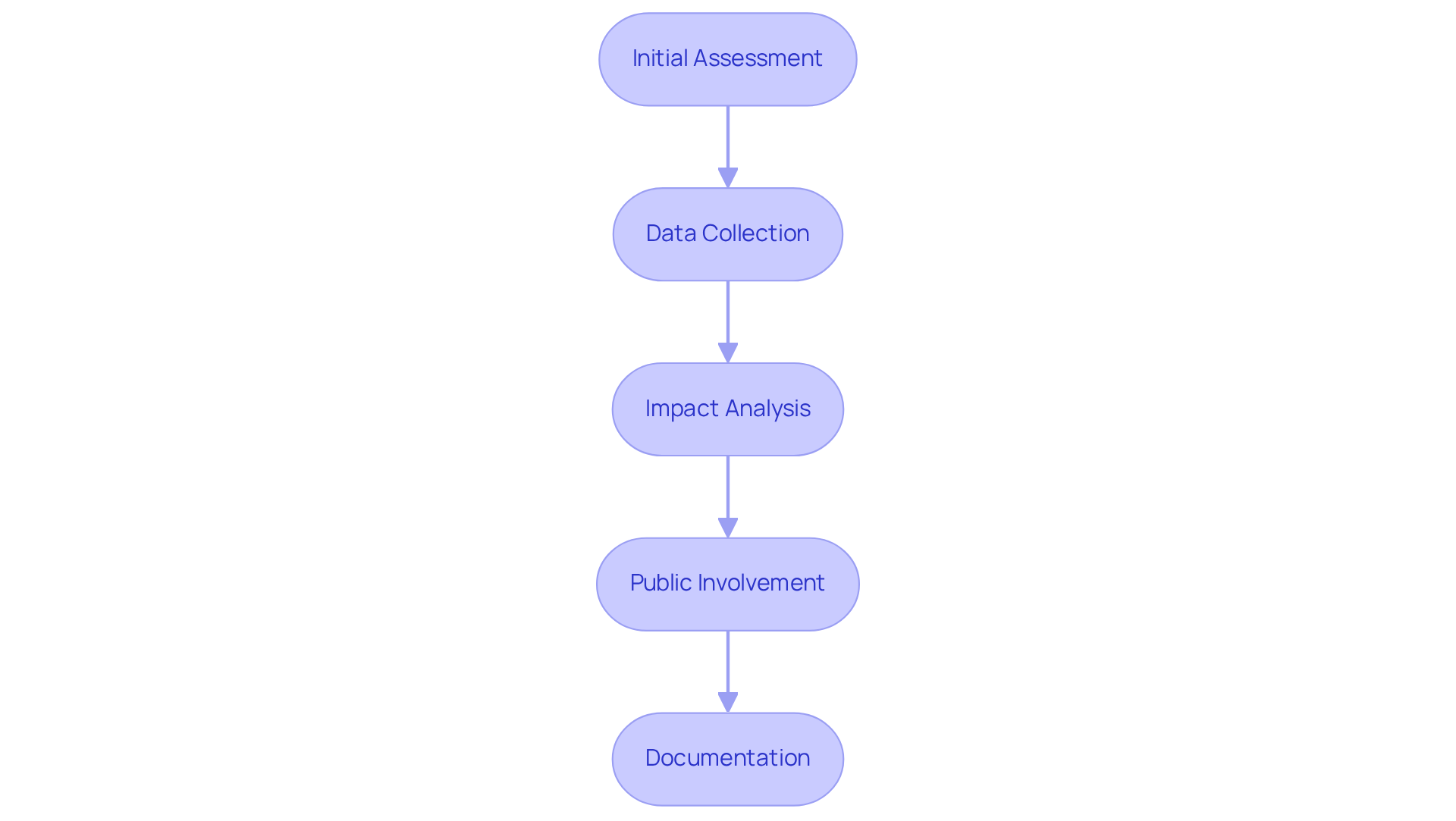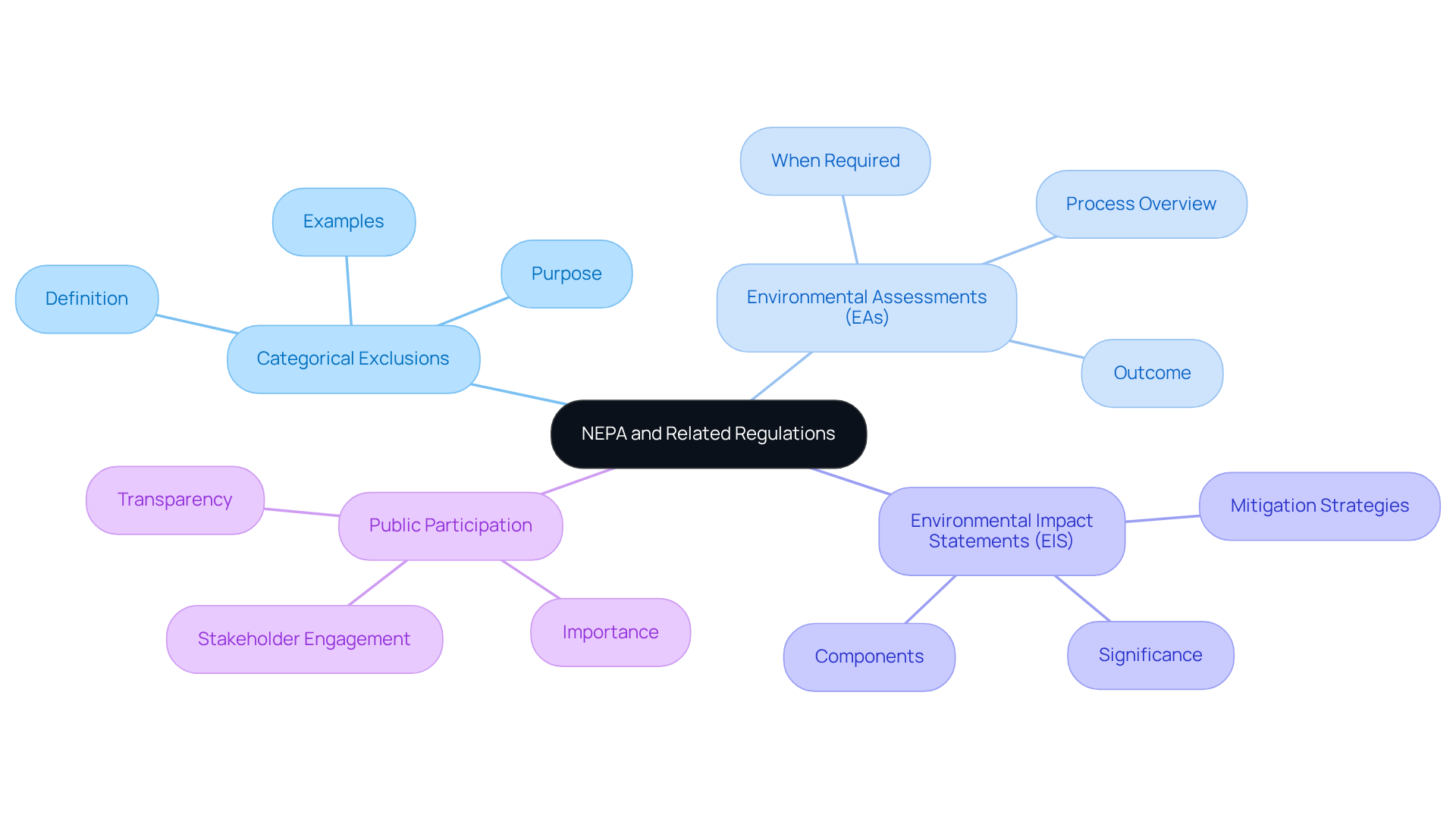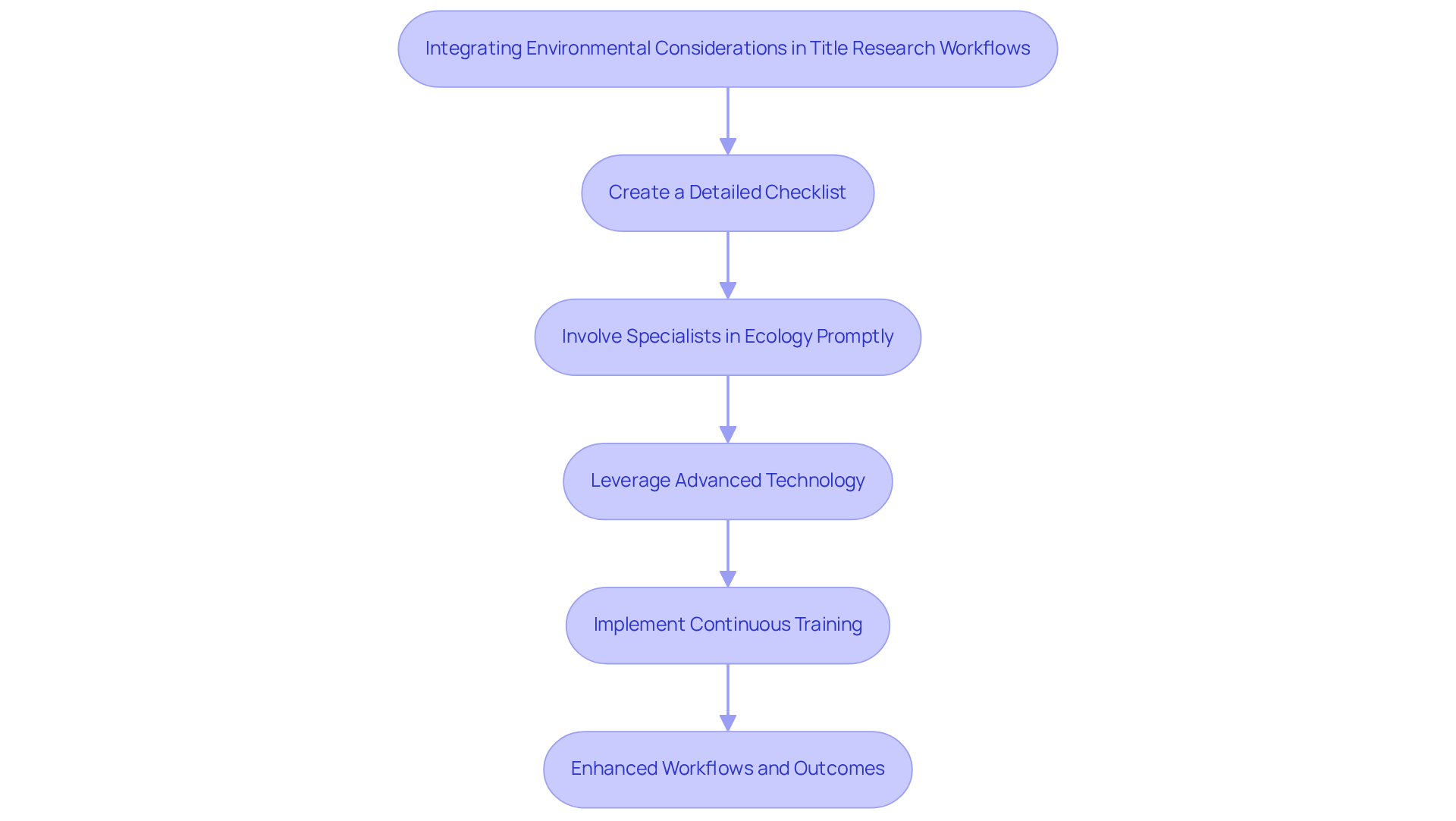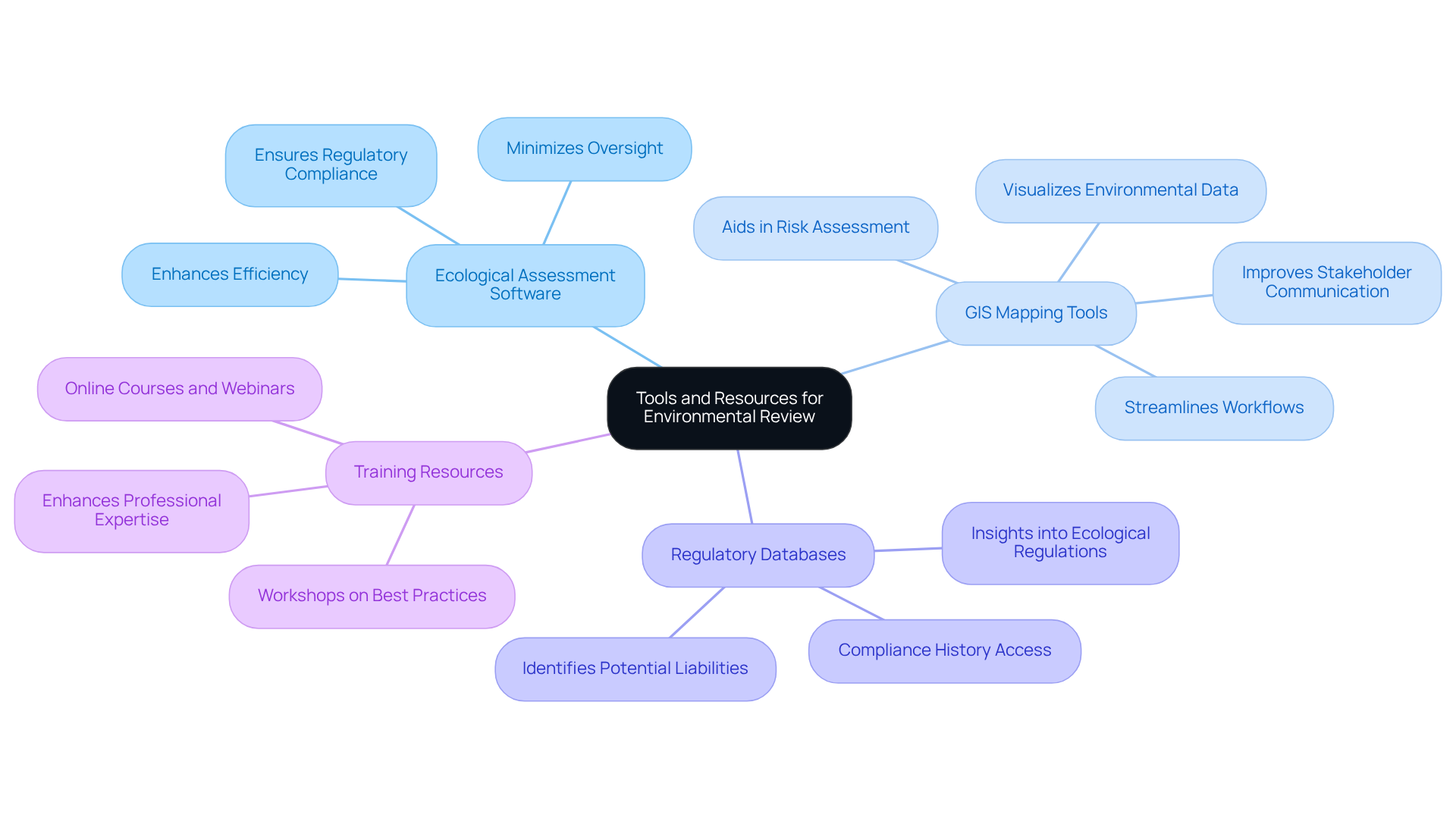Overview
The article underscores the critical importance of integrating environmental considerations into title review workflows to guarantee comprehensive ecological assessments in property transactions. It presents a structured approach that encompasses:
- Initial assessments
- Data collection
- Public involvement
- The application of advanced technology and resources
This method is designed to enhance compliance and improve project outcomes in the real estate sector. By adopting such practices, stakeholders can ensure that environmental factors are adequately addressed, ultimately leading to more sustainable property transactions.
Introduction
Integrating environmental considerations into title review workflows is not merely a regulatory necessity; it represents a pivotal step toward ensuring sustainable real estate development. As property transactions increasingly intersect with ecological impacts, title researchers encounter the challenge of navigating complex environmental assessments while maintaining compliance with regulations such as NEPA.
How can professionals effectively incorporate these critical factors into their workflows to enhance both diligence and project outcomes? This article delves into best practices and innovative tools that empower title researchers to seamlessly integrate environmental considerations, ultimately fostering more informed decision-making in property evaluations.
Understand Environmental Review Processes
Review procedures are crucial for assessing the potential ecological effects associated with a project or property, particularly when incorporating environmental considerations in title review. Title researchers must analyze various factors, including , contamination, hazardous materials, and adherence to local, state, and federal regulations. Mastery of the following steps in these reviews is vital:
- Initial Assessment: Define the review's scope and identify pertinent regulations for the property.
- Data Collection: Compile relevant documents, such as previous assessments, land use records, and existing reports.
- Impact Analysis: Examine potential ecological impacts, concentrating on historical contamination and ongoing ecological issues.
- Public Involvement: Engage stakeholders and the community to gather input and address concerns regarding ecological impacts. As Tom Turner emphasizes, "Single-purposism tends to create projects that harm the environment. Instead, we should design projects with as positive an ecological impact as possible."
- Documentation: Create comprehensive reports detailing findings and recommendations for mitigating identified risks.
By mastering these processes, title investigators can adeptly navigate the complexities of ecological assessments, ensuring that environmental considerations in title review are included for thorough due diligence in property transactions. This diligence not only safeguards compliance but also enhances the overall integrity of the transaction, ultimately benefiting all parties involved. Furthermore, utilizing resources like the Interactive Map for Environmental Review Projects can provide valuable insights and transparency, further supporting informed decision-making in property transactions.

Familiarize with NEPA and Related Regulations
The National Environmental Policy Act (NEPA) mandates that federal agencies assess the ecological effects of their proposed actions prior to decision-making. Title researchers must comprehend several critical components of NEPA to adeptly navigate their responsibilities:
- Categorical Exclusions: Certain actions may qualify for categorical exclusions, enabling them to bypass extensive ecological assessments. This provision aims to for projects with minimal ecological impact.
- Environmental Assessments (EAs): When a project does not meet the criteria for a categorical exclusion, an EA is conducted. This evaluation determines whether a more detailed Environmental Impact Statement (EIS) is necessary based on the potential effects on the environment.
- Environmental Impact Statements (EIS): For projects expected to have significant environmental repercussions, an EIS is required. This document outlines potential impacts, alternatives, and mitigation strategies, providing a comprehensive analysis for decision-makers.
- Public Participation: NEPA emphasizes the significance of public engagement, mandating that agencies actively seek input from stakeholders and the community. This process not only enhances transparency but also fosters collaboration among various stakeholders involved in real estate development.
By acquiring a robust understanding of NEPA and its implications, professionals can skillfully navigate the regulatory framework, ensuring compliance and addressing environmental considerations in title review to promote smoother workflows in their research activities. Successful case studies of categorical exclusions illustrate how efficient compliance can lead to timely project approvals, ultimately benefiting both the environment and the real estate sector.

Integrate Environmental Considerations into Title Research Workflows
To effectively integrate environmental considerations into title research workflows, title researchers should adopt the following best practices:
- Create a Detailed Checklist: Develop a checklist that includes key ecological aspects to evaluate during the review phase. This should encompass historical land use, proximity to hazardous locations, and adherence to regulations, ensuring a comprehensive assessment of potential risks.
- Involve Specialists in Ecology Promptly: Work together with consultants in ecology from the beginning of the research process. Their expertise can help identify potential ecological issues and develop effective mitigation strategies, fostering a proactive approach to compliance and risk management. Expert opinions suggest that early engagement can significantly enhance the quality of assessments and streamline workflows.
- Leverage Advanced Technology: Utilize machine learning and optical character recognition tools to streamline data extraction from environmental reports and document titles. This technology not only boosts efficiency but also enhances precision, enabling professionals to concentrate on critical analysis instead of manual data entry. Statistics indicate that organizations that streamline their processes can see efficiency increases of up to 23%, particularly when leveraging advanced technology.
- Implement Continuous Training: Offer regular instruction for title specialists on regulatory guidelines and optimal methods. Keeping staff informed about the latest developments in ecological law is crucial for maintaining compliance and enhancing the quality of assessments. Training programs should also that individuals might face, such as misinterpretation of regulations or inadequate risk assessments.
By applying these strategies, property analysts can greatly enhance their workflows, ensuring that environmental considerations in title review are thoroughly integrated into property evaluations. Case studies have shown that organizations that effectively integrate these practices not only enhance compliance but also improve overall project outcomes.

Utilize Tools and Resources for Effective Environmental Review
To conduct effective environmental reviews, title researchers must leverage a range of tools and resources, including:
- Ecological Assessment Software: Investing in software solutions that simplify the analysis of ecological data and automate report creation is essential. This not only enhances efficiency but also minimizes the risk of oversight in complex regulatory landscapes, ensuring adherence to regulatory requirements.
- GIS Mapping Tools: Geographic Information Systems (GIS) should be utilized to visualize critical environmental data, such as contamination sites and protected areas. GIS mapping significantly aids in risk assessment by providing dynamic visual representations that enhance stakeholder communication and decision-making processes. Research indicates that GIS tools can improve the precision of environmental assessments, leading to more informed property evaluations. Notably, GIS mapping has been shown to streamline workflows and increase assessment accuracy, making it indispensable in today's real estate sector.
- Regulatory Databases: Access to comprehensive databases is crucial for insights into ecological regulations, compliance history, and potential liabilities associated with properties. These resources are vital for understanding the regulatory framework and recognizing any ecological risks that may impact property transactions.
- : Engaging in online courses, webinars, and workshops focused on review processes and best practices related to ecology is imperative. Ongoing education enhances the expertise and capabilities of professionals in the field, equipping them to effectively manage the complexities of environmental assessments.
By effectively utilizing these tools and resources, title researchers can significantly enhance the quality and efficiency of their assessments, ultimately leading to more informed decision-making in real estate transactions that include environmental considerations in title review. The integration of GIS tools, in particular, has been demonstrated to streamline workflows and improve the accuracy of environmental evaluations, rendering them essential in today's real estate landscape.

Conclusion
Integrating environmental considerations into title review workflows is essential for ensuring that property transactions are conducted with a comprehensive understanding of their ecological impacts. This approach not only promotes compliance with regulations but also enhances the integrity of the real estate process, ultimately benefiting all stakeholders involved.
The article outlines critical steps in the environmental review process, emphasizing the importance of:
- Thorough assessments
- Stakeholder engagement
- Adherence to regulations like NEPA
By leveraging advanced technology, fostering collaboration with ecological specialists, and implementing continuous training, title researchers can streamline workflows and improve the accuracy of their evaluations. Tools such as GIS mapping and ecological assessment software serve as invaluable resources for enhancing the quality of environmental reviews, enabling informed decision-making in real estate transactions.
The significance of integrating environmental considerations cannot be overstated. As the landscape of real estate development continues to evolve, professionals must remain vigilant and proactive in their approaches to environmental assessments. By embracing best practices and utilizing the right tools, title researchers can contribute to sustainable development and ensure that ecological factors are prioritized in every property transaction. This commitment not only safeguards the environment but also fosters a more responsible and informed real estate market.
Frequently Asked Questions
What is the purpose of environmental review processes?
Environmental review processes are crucial for assessing the potential ecological effects associated with a project or property, particularly when incorporating environmental considerations in title review.
What factors must title researchers analyze during environmental reviews?
Title researchers must analyze factors including environmental considerations in title review, contamination, hazardous materials, and adherence to local, state, and federal regulations.
What are the key steps in the environmental review process?
The key steps include Initial Assessment, Data Collection, Impact Analysis, Public Involvement, and Documentation.
What is involved in the Initial Assessment step?
The Initial Assessment involves defining the review's scope and identifying pertinent regulations for the property.
What kind of documents should be compiled during Data Collection?
Relevant documents to compile include previous assessments, land use records, and existing reports.
What does Impact Analysis focus on?
Impact Analysis examines potential ecological impacts, concentrating on historical contamination and ongoing ecological issues.
Why is Public Involvement important in the review process?
Public Involvement is important to engage stakeholders and the community to gather input and address concerns regarding ecological impacts.
What does the Documentation step entail?
The Documentation step involves creating comprehensive reports detailing findings and recommendations for mitigating identified risks.
How does mastering environmental review processes benefit title investigators?
Mastering these processes allows title investigators to navigate the complexities of ecological assessments, ensuring thorough due diligence in property transactions, safeguarding compliance, and enhancing the overall integrity of the transaction.
What resource can provide additional insights for environmental reviews?
The Interactive Map for Environmental Review Projects can provide valuable insights and transparency to support informed decision-making in property transactions.




